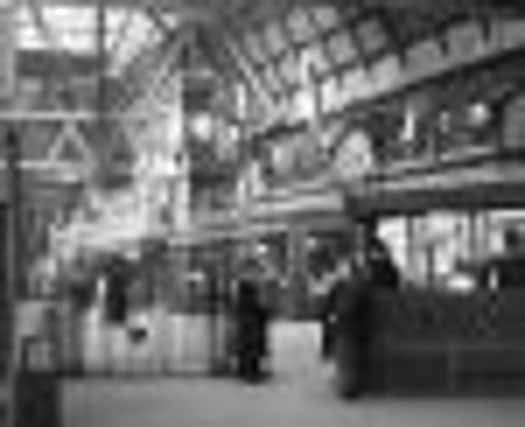Lost Edinburgh: Princes Street Station


The western based Caledonian Railway Company first extended a line into Edinburgh in 1848, which saw the erection of a temporary wooden station on Lothian Road. The initial Lothian Road station persisted until 1870 when the line was extended a little further north towards Princes Street, the shift in location forcing a name change. By the 1890s, with passenger levels rapidly increasing, the decision was taken by The Caledonian Railway Company to create a grand terminal for Edinburgh - one to rival Edinburgh Waverley. Boasting 7 platforms, street level access and a colossal 850ft long bayed roof, it was a formidable opponent to Edinburgh’s other station. One unique and rather curious feature, was the use of red sandstone (more commonly found in the west of Scotland) throughout the station’s façade. As well as acknowledging the company’s Glaswegian roots, it would have been extremely cost-effective for The Caledonian Railway to transport the quarried stone from the west direct to the capital along their own line.
As the turn of the last century approached, an influx of tourism, particularly among the upper classes, provoked many rail companies to cash in by providing convenient onsite accommodation for their passengers. 1902 saw the North British railway company build a grand and luxurious hotel (Today we know it as ‘The Balmoral’) at the east end of Princes Street. Its proposed construction in 1895 would have undoubtedly spurred those running the Caledonian line into action. Thus, on December 21st 1903, The Caledonian Hotel, officially opened. The hotel was clearly designed to be the focal point of the entire complex having been built directly above the pre-existing station that faced Princes Street. A new entrance from Rutland Street, featuring ornate iron gates that are still there today, provided the station with adequate vehicle access.
Advertisement
Hide AdAdvertisement
Hide AdUp until the end of the Second World War, Princes Street Station thrived. It became the preferred arrival destination for the British monarchy on state visits to the city. Its ease of access to Edinburgh’s main thoroughfare was deemed an absolute necessity for the purpose of processions, with the alternative prospect of tackling the steep inclines of Edinburgh Waverley perceived as being significantly less favourable. However, in 1948 with the advent of nationalisation across Britain’s numerous railway networks, Princes Street Station, despite its size, opulent interior and regal approval, was deemed surplus to requirements. Over the following 17 years, service was reduced gradually station by station, sleeper by sleeper, until September 1965 when the grand Princes Street terminal finally met the end of the line.
Few remnants of Princes Street Station have survived since the 1960s, though fragments are still evident. The newly refurbished Caledonian Hotel, no longer under railway ownership, is an obvious example, with the aforementioned cast iron gates on Rutland Street now providing an elaborately styled hotel car park entrance. Also within the hotel, since its £24m conversion into a Waldorf Astoria, resides the old station clock - restored yet still set 5 minutes fast to ensure passengers made their trains on time. The West Approach Road, completed during the 1980s, runs along much of the former track bed of the main line and travellers passing underneath the iron bridges spanning Morrison Street, Gardner’s Crescent and Grove Street are provided further evidence of the road’s previous incarnation. The once heavily active Lothian Road parcels office, situated between the hotel and the West Approach Road, endured until the early 1990s, later becoming the site of Standard Life. The remainder of the large gap site left in the station’s wake has also seen dramatic redevelopment over the past 25 years, its sheer scale enabling Edinburgh to create a bustling financial district within the city centre. Princes Street Station certainly deserves more than a footnote in the annals of Edinburgh’s rich civic history, but the fact that its demise has ultimately led to genuine economic prosperity for the capital has softened the impact of its loss.